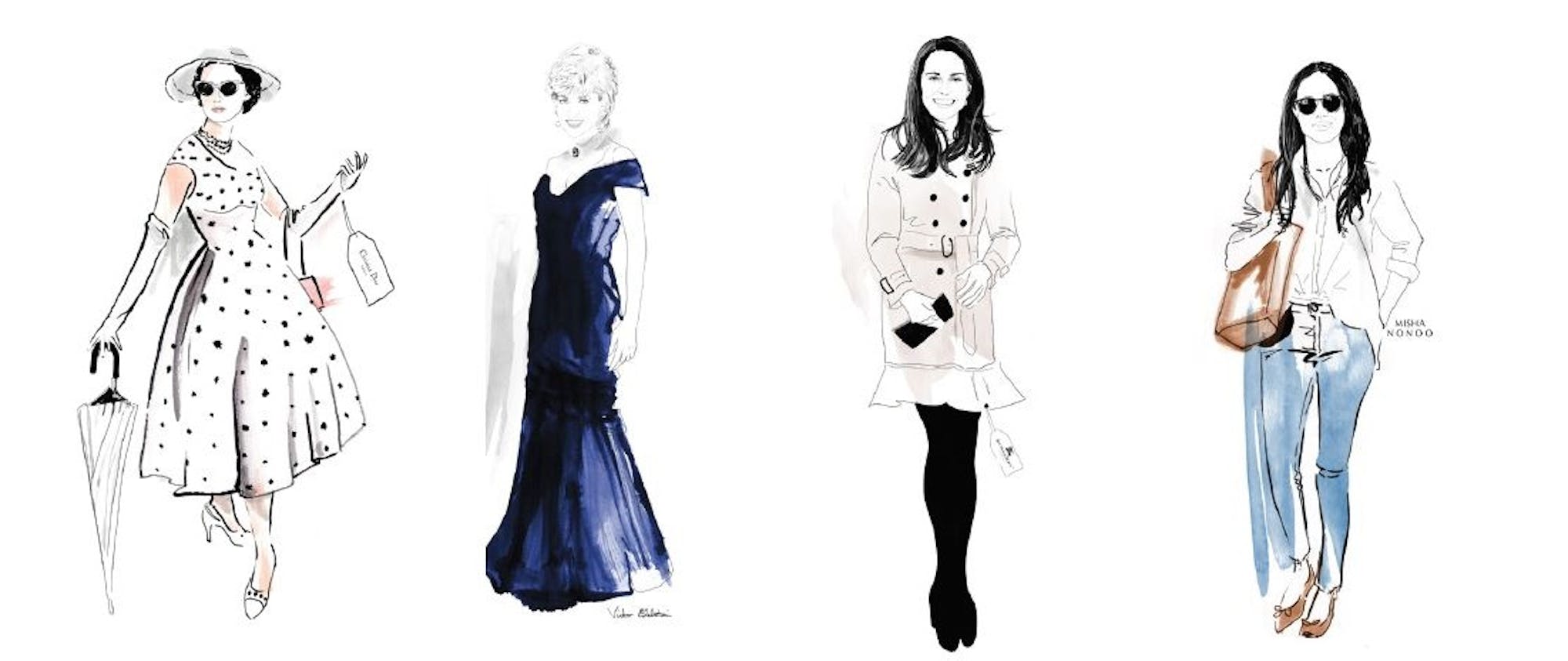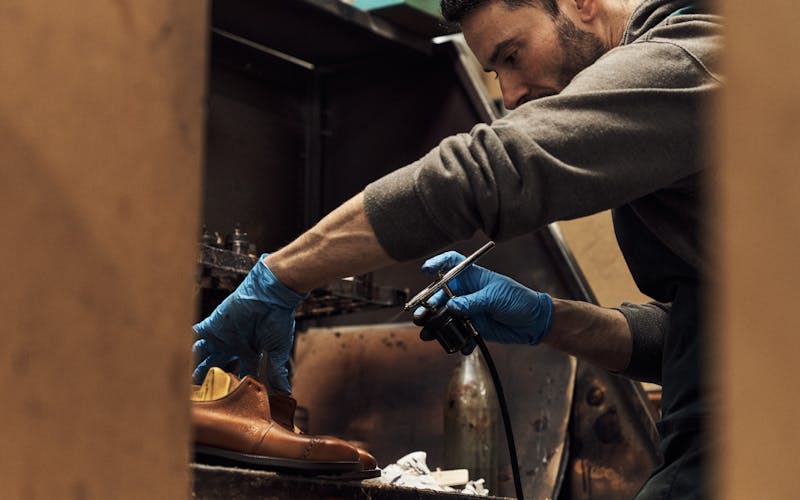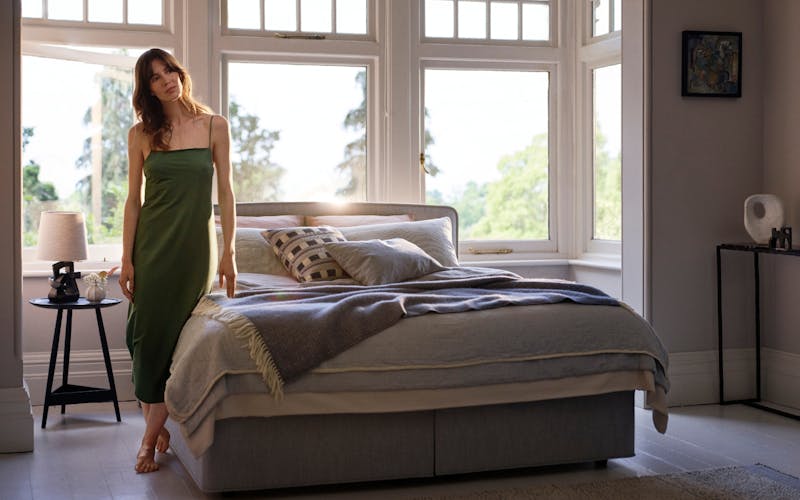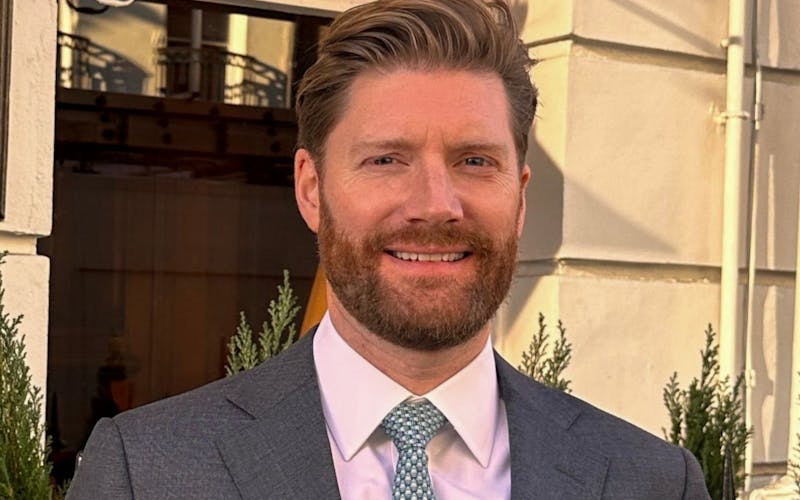

for Walpole members and
non-members available now
at The Londoner



Illustration by Jo Bird.
When Meghan Markle stepped out at the Invictus Games, on her first official appearance with Prince Harry, it not only marked the beginning of her integration into the royal family, it also propelled a handful of independent designers into the spotlight. From her white ‘husband shirt’ by her friend Misha Nonoo to her brown leather flats by Sarah Flint, every item she wore enjoyed an instant surge in sales. Among them was the British luxury eyewear designer brand Finlay & Co – the sheer volume of interest generated by Markle wearing its tortoiseshell frames saw its website crash and purchases rise by 2,200 per cent in the US alone. The Scottish accessories label Strathberry had a similar experience after Markle was first pictured with one of its tote bags in December 2017, which caused its stock to sell out in a mere 11 minutes.
Since her marriage, the public’s fascination with the Duchess of Sussex has become even stronger, putting her almost on par with her sister-in-law, the Duchess of Cambridge, who has been the leading royal influencer for years, her every outfit carefully scrutinised. From her support of luxury brands such as Alexander McQueen and Burberry, to independents like Penelope Chilvers and Goat, the tangible commercial benefits of the ‘Kate effect’ are a blessing to British industry, boosting revenue by roughly £152 million annually, according to a 2015 estimate.
More than any celebrity or model, the Duchesses of Sussex and Cambridge have global influence in their ability to make others want to emulate their style. “The royal impact on the desirability of British luxury brands cannot be overstated,” says Alex Haigh, director of Brand Finance. “Interaction between a brand and any royal, but particularly the duchesses, is like the mythical golden touch and can transform a brand’s performance overnight.”
With endless news stories chronicling their style, and countless images circulating on Instagram, it might seem as if this regal obsession is a peculiarly modern phenomenon. But if you trace the history of the British royal family, you can see that it has always been the case, from Queen Elizabeth I, who started the Tudor trend for pale skin and red hair, to Queen Victoria, who single-handedly introduced the white wedding dress.
Every generation looks to the royal family for sartorial inspiration – while the fortunes of celebrities rise and fall over time, the royals are a beacon of longevity in a rapidly changing world. Although they are among the most scrutinised people on the planet, they are perennially on-duty and always retain an element of mystery, rarely voicing their individual opinions. Even the Duchess of Sussex, who as an actress was well-known in her own right before meeting Prince Harry, deleted her blog and her social media accounts before her marriage. Members of the royal family are compelling precisely because they are so enigmatic, hence the enduring fascination with their clothes. This is the only window we have into their true personalities, and they choose their garments with care, often selecting pieces with a symbolic value.
While the men are mostly confined to a uniform of suits or military regalia, it is the women who have truly honed the art of dressing for the public stage. It is no coincidence that two months after her wedding the Duchess of Sussex wore a green Givenchy blouse and skirt when she first set foot in Dublin on an official visit, in a subtle nod to the country’s national colour, or that the Duchess of Cambridge sported a diamond brooch in the shape of a maple leaf upon her arrival in Canada for a state visit. They are able to convey goodwill and diplomacy without having to say a word.
In a world where stealth advertising and celebrity endorsements are rife, the commercially independent status of the royal family is refreshing. They champion small designers, prioritise quality and longevity, and wear clothes that are perfectly suited to whatever occasion they attend."
The Queen, of course, is well-versed in this, and over the many decades of her reign she has mastered the intricacies of royal dressing better than anyone. As a young princess in 1940s Britain, she so captured the nation’s hearts that they sent in their own clothing coupons to enable her to have a sumptuous wedding dress in spite of post-war rationing. Taking inspiration from Botticelli’s Primavera, the Norman Hartnell gown was almost entirely covered with floral motifs to symbolise the regeneration and growth that was tentatively emerging in the wake of two devastating world wars. As the heir to the throne, this royal bride was particularly significant – she heralded a new Elizabethan age of modernity and promise, a sign of spring flowering after a long winter. “I marked in circles the rich white roses of York to be carried out in padded satin, and centred by raised strands of pearls threaded on silver wire and raised up in relief,” wrote Hartnell in his memoirs. “Wherever there was space or weakness of design I drew more wheat, more leaves, more blossom of orange, syringa or jasmine.”
Viewers of The Crown will be familiar with how the Queen’s wardrobe evolved in the first ten years of her reign, moving from spectacular dresses of taffeta and chiffon to the seeds of the style that she still favours today. In her youth, she possessed the same star allure that the two duchesses have today. The diarist Chips Channon described seeing the young princess and her husband at a ball at Windsor Castle in 1949: “The Edinburghs looked divine... She wore a very high tiara and the Garter – he was in the dark blue Windsor uniform… they looked like characters out of a fairy tale…” From early on, the Queen favoured bright colours, knowing that they helped her to stand out in a crowd. She also learnt how to dress in a way that enabled her to stay composed and put-together under pressure – her skirts often had weighted hems, so they would not blow up on windy days, and she favoured garments with zips, which enabled her to change between outfits quickly and without ruffling her hairstyle.
While the Queen was admired for her elegance, her sister, Princess Margaret, was equally well regarded, and her lesser status afforded her greater sartorial freedom. Christian Dior dressed her in the New Look, and she habitually favoured bold accessories, from bright headscarves to statement sunglasses. Her style became so iconic during the 1950s that it was referred to as ‘The Margaret Look’, and she was celebrated for her rebellious vivacity, conveyed perfectly by her choice of clothes.
However, it was Princess Diana who was the greatest royal influencer of all. From the start, women everywhere sought to emulate her style. Copies of her voluminous wedding dress were selling within days of her nuptials at St Paul’s and led to a long-running trend for puffy white gowns, while her early uniform of pie-crust collars and leg-of-mutton sleeves made her an inspiration to every aspiring Sloane Ranger. A 1981 photograph of her in Vogue, in a pale pink Emanuel shirt, sparked a nationwide run on pussy-bow ‘Lady Di’ blouses. As the years passed, her style evolved from the New Romantic frills of the 1980s to the bodycon silhouette of the 1990s, and she became adept at perfectly tailoring her attire to suit the occasion. A memorable Catherine Walker cream silk dress from 1986, designed for an overseas visit to Saudi Arabia, revealed her skill at diplomatic dressing, showing a delicate mark of respect with its high neckline, long sleeves and a flock of shimmering falcons – the country’s national symbol – cascading down the bodice. Several months before her death in 1997, she auctioned off a portion of her wardrobe at Christie’s in New York to raise funds for charity. It raised a staggering $3.25 million in total, with the highest bid for a midnight-blue velvet gown that she wore when she danced at the White House with John Travolta in 1985. A number of these dresses were brought together for the highly popular Kensington Palace exhibition Diana: Her Fashion Story, which chronicled the extraordinary scope and enduring power of her style.
After Diana, the royal family spent many years without a young female figurehead, until the Palace’s announcement in 2010 that Kate Middleton was engaged to Prince William. Their official engagement photograph mirrored the one of his parents almost 30 years before – with Middleton wearing a blue Issa dress that matched the sapphire and diamond Garrard ring that had belonged to Diana. That moment represented the start of Kate Middleton’s transformation into the Duchess of Cambridge and a global ambassador of British style, like so many generations of royal women before her. The addition of the Duchess of Sussex has increased the demand for British brands still further, particularly in the US.
In a world where stealth advertising and celebrity endorsements are rife, the commercially independent status of the royal family is refreshing. They champion small designers, prioritise quality and longevity, and wear clothes that are perfectly suited to whatever occasion they attend. In 20 years, it may well be Princess Charlotte who shapes future fashions, but for now, the two duchesses have the ability to bless any brand they choose with their golden touch. There could be no better champions for British luxury – long may they flourish.
Royal Influence appeared in the 2019 Book of British Luxury. We are now taking bookings for the 2020 Book of British Luxury, click here: 2020 Media Kit to find out more or please contact Stephanie Robinson.
Catriona Gray
Catriona is a freelance journalist, based between London and Ireland. Previously the commissioning editor at Harper’s Bazaar and Town & Country, she has worked at various luxury publications, including GQ and House & Garden. She is the author of two non-fiction books on the history of design.





